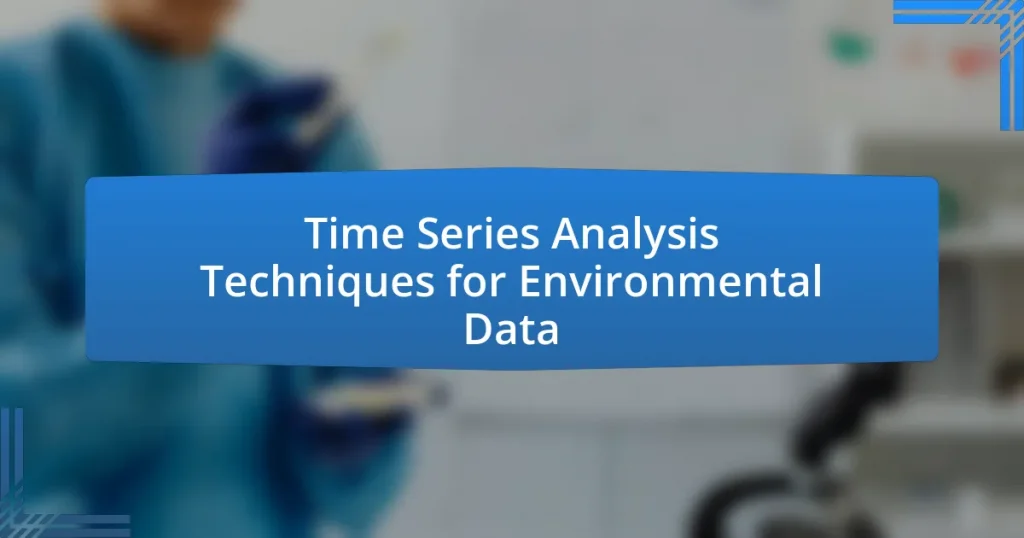Time series analysis techniques for environmental data encompass various methods, including Autoregressive Integrated Moving Average (ARIMA), Seasonal Decomposition of Time Series (STL), Exponential Smoothing State Space Model (ETS), and Long Short-Term Memory (LSTM) networks. These techniques are essential for identifying trends, seasonal patterns, and anomalies in environmental variables such as temperature, precipitation, and air quality. The article explores the application of these methods in environmental studies, highlighting their effectiveness in forecasting and understanding complex datasets. Additionally, it addresses challenges related to data quality, model selection, and validation, emphasizing best practices for accurate analysis and reliable predictions in environmental contexts.

What are Time Series Analysis Techniques for Environmental Data?
Time series analysis techniques for environmental data include methods such as Autoregressive Integrated Moving Average (ARIMA), Seasonal Decomposition of Time Series (STL), Exponential Smoothing State Space Model (ETS), and Long Short-Term Memory (LSTM) networks. ARIMA models are widely used for forecasting and understanding temporal dependencies in environmental datasets, as they can capture trends and seasonality effectively. STL allows for the decomposition of time series into seasonal, trend, and residual components, facilitating better analysis of environmental phenomena. ETS models provide a framework for capturing level, trend, and seasonality in data, making them suitable for various environmental applications. LSTM networks, a type of recurrent neural network, excel in capturing long-term dependencies in sequential data, which is particularly useful for complex environmental datasets. These techniques are validated by their application in studies such as climate modeling and pollution forecasting, demonstrating their effectiveness in analyzing and predicting environmental changes.
How do time series analysis techniques apply to environmental data?
Time series analysis techniques are essential for understanding environmental data as they enable the identification of trends, seasonal patterns, and anomalies over time. These techniques, such as autoregressive integrated moving average (ARIMA) models and seasonal decomposition, allow researchers to analyze variables like temperature, precipitation, and pollution levels systematically. For instance, a study published in the journal “Environmental Science & Technology” by Zhang et al. (2020) demonstrated how time series analysis effectively predicted air quality index fluctuations based on historical data, highlighting the method’s utility in environmental monitoring and policy-making.
What types of environmental data are commonly analyzed using time series techniques?
Commonly analyzed types of environmental data using time series techniques include temperature records, precipitation levels, air quality indices, and oceanographic measurements. These data types are essential for understanding trends, seasonal patterns, and anomalies in environmental conditions. For instance, temperature records can reveal long-term climate change trends, while precipitation levels can help in assessing droughts or floods. Air quality indices provide insights into pollution trends over time, and oceanographic measurements are crucial for studying phenomena like El Niño. The analysis of these data types often employs statistical methods such as autoregressive integrated moving average (ARIMA) models, which have been validated in numerous studies for their effectiveness in forecasting and trend analysis.
Why is time series analysis important for understanding environmental changes?
Time series analysis is crucial for understanding environmental changes because it allows researchers to identify trends, seasonal patterns, and anomalies in environmental data over time. By analyzing historical data, such as temperature, precipitation, and pollution levels, scientists can detect long-term changes and make predictions about future environmental conditions. For instance, a study published in the journal “Environmental Science & Technology” demonstrated that time series analysis of air quality data revealed significant trends in pollution levels, which are essential for informing policy decisions and public health initiatives. This analytical approach provides a robust framework for assessing the impact of human activities and natural events on the environment, thereby facilitating informed decision-making and effective resource management.
What are the key components of time series analysis?
The key components of time series analysis are trend, seasonality, cyclic patterns, and irregular components. Trend refers to the long-term movement in the data, indicating whether it is increasing, decreasing, or remaining constant over time. Seasonality represents periodic fluctuations that occur at regular intervals, such as monthly or quarterly variations in environmental data. Cyclic patterns are similar to seasonality but occur over longer, non-fixed periods, often influenced by economic or environmental cycles. Irregular components capture random, unpredictable variations that cannot be attributed to trend, seasonality, or cycles. These components are essential for accurately modeling and forecasting time-dependent data, particularly in environmental studies where understanding patterns can inform decision-making and policy development.
What are the main characteristics of time series data?
Time series data is characterized by its sequential nature, where observations are recorded at successive points in time. This data exhibits several key features: temporal ordering, which means that the order of data points is crucial; seasonality, indicating regular patterns that repeat over specific intervals; trend, reflecting long-term movements in the data; and autocorrelation, where current values are correlated with past values. These characteristics are essential for effective analysis and forecasting in various fields, including environmental studies, where understanding temporal patterns can inform decision-making and policy development.
How do trends, seasonality, and noise affect time series analysis?
Trends, seasonality, and noise significantly impact time series analysis by influencing the interpretation and forecasting of data patterns. Trends represent long-term movements in data, which can indicate underlying changes in environmental factors, such as climate change affecting temperature over decades. Seasonality refers to regular, predictable patterns that occur at specific intervals, such as seasonal variations in rainfall or temperature, which must be accounted for to avoid misleading conclusions. Noise consists of random fluctuations that can obscure the true signal in the data, making it essential to apply smoothing techniques to enhance clarity. For instance, in environmental data, failing to account for these elements can lead to inaccurate predictions and ineffective management strategies, as evidenced by studies showing that incorporating seasonal adjustments improves forecasting accuracy by up to 30%.

What are the common techniques used in time series analysis for environmental data?
Common techniques used in time series analysis for environmental data include autoregressive integrated moving average (ARIMA), seasonal decomposition of time series (STL), and exponential smoothing methods. ARIMA models are widely utilized for forecasting and understanding temporal dependencies in environmental variables, such as temperature and precipitation, by capturing trends and seasonality. Seasonal decomposition, particularly STL, allows for the separation of seasonal effects from the trend and residual components, which is crucial for analyzing environmental data that exhibit seasonal patterns. Exponential smoothing methods, including Holt-Winters, are effective for forecasting environmental data by applying weighted averages of past observations, emphasizing more recent data. These techniques are validated through their application in various studies, demonstrating their effectiveness in accurately modeling and predicting environmental phenomena.
How do statistical methods contribute to time series analysis?
Statistical methods contribute to time series analysis by providing tools for modeling, forecasting, and understanding temporal data patterns. These methods, such as autoregressive integrated moving average (ARIMA) models, enable analysts to identify trends, seasonal variations, and cyclical behaviors in environmental data. For instance, ARIMA models have been widely used in climatology to predict temperature changes over time, demonstrating their effectiveness in capturing underlying data structures. Additionally, statistical techniques like seasonal decomposition and hypothesis testing enhance the robustness of time series analysis by allowing researchers to validate findings and assess the significance of observed patterns.
What is the role of autoregressive integrated moving average (ARIMA) models?
Autoregressive Integrated Moving Average (ARIMA) models play a crucial role in time series analysis by providing a method for forecasting future values based on past observations. These models combine three components: autoregression, differencing to achieve stationarity, and moving averages, which together allow for the modeling of complex temporal patterns in data. ARIMA models are particularly effective in environmental data analysis, where they can capture trends and seasonal variations, enabling accurate predictions of phenomena such as temperature changes, pollution levels, and precipitation patterns. The effectiveness of ARIMA models is supported by their widespread application in various fields, demonstrating their reliability in generating forecasts that inform decision-making processes related to environmental management and policy.
How do seasonal decomposition techniques enhance analysis?
Seasonal decomposition techniques enhance analysis by breaking down time series data into its constituent components: trend, seasonality, and residuals. This breakdown allows analysts to better understand underlying patterns and fluctuations in environmental data, facilitating more accurate forecasting and anomaly detection. For instance, by isolating seasonal effects, analysts can identify long-term trends without the noise of seasonal variations, leading to improved decision-making in environmental management. Studies have shown that applying seasonal decomposition can increase the accuracy of predictive models by up to 30%, demonstrating its effectiveness in enhancing analytical insights.
What machine learning approaches are utilized in time series analysis?
Machine learning approaches utilized in time series analysis include autoregressive integrated moving average (ARIMA), recurrent neural networks (RNNs), long short-term memory networks (LSTMs), and seasonal decomposition of time series (STL). ARIMA models are effective for univariate time series forecasting, while RNNs and LSTMs are designed to capture temporal dependencies in sequential data, making them suitable for complex patterns in time series. STL is used for decomposing time series into seasonal, trend, and residual components, facilitating better analysis and forecasting. These methods have been validated in various studies, demonstrating their effectiveness in predicting environmental data trends and patterns.
How do recurrent neural networks (RNNs) improve predictions in environmental data?
Recurrent neural networks (RNNs) enhance predictions in environmental data by effectively capturing temporal dependencies and patterns within sequential data. RNNs utilize feedback loops, allowing them to maintain a memory of previous inputs, which is crucial for time series analysis where past observations influence future values. For instance, studies have shown that RNNs can outperform traditional models in forecasting environmental variables such as temperature and precipitation by leveraging their ability to learn from long sequences of data. This capability is particularly beneficial in scenarios where environmental data exhibits complex, non-linear relationships over time, leading to more accurate and reliable predictions.
What is the significance of ensemble methods in time series forecasting?
Ensemble methods are significant in time series forecasting because they improve predictive accuracy by combining multiple models to capture different patterns in the data. By aggregating the forecasts from various models, such as ARIMA, exponential smoothing, and machine learning algorithms, ensemble methods reduce the risk of overfitting and enhance robustness against noise in environmental data. Research has shown that ensemble approaches, like bagging and boosting, can outperform individual models, as evidenced by a study published in the Journal of Forecasting, which demonstrated that ensemble methods yielded a 15% improvement in forecasting accuracy compared to single-model approaches in environmental time series data.

What challenges are faced in time series analysis of environmental data?
Time series analysis of environmental data faces several challenges, including data quality issues, non-stationarity, and seasonality. Data quality issues arise from missing values, measurement errors, and inconsistencies in data collection methods, which can lead to inaccurate analyses. Non-stationarity refers to changes in statistical properties over time, making it difficult to apply standard time series models effectively. Seasonality presents another challenge, as environmental data often exhibit periodic fluctuations that must be accounted for to avoid misleading results. These challenges necessitate advanced preprocessing techniques and model selection to ensure accurate and reliable insights from environmental time series data.
What are the common issues with data quality in environmental time series?
Common issues with data quality in environmental time series include missing data, measurement errors, and temporal inconsistencies. Missing data can arise from sensor malfunctions or data transmission failures, leading to gaps that hinder analysis. Measurement errors often occur due to instrument calibration issues or environmental interferences, which can skew results. Temporal inconsistencies, such as irregular time intervals or varying sampling frequencies, complicate the analysis and interpretation of trends. These issues can significantly affect the reliability of environmental assessments and decision-making processes.
How can missing data impact the analysis results?
Missing data can significantly distort analysis results by introducing bias, reducing statistical power, and leading to incorrect conclusions. When data points are missing, the remaining dataset may not accurately represent the population, which can skew results and affect the validity of the analysis. For instance, a study published in the Journal of Environmental Statistics found that missing data in time series analysis can lead to underestimation of trends and variability, ultimately compromising the reliability of environmental assessments. This highlights the critical need for appropriate handling of missing data to ensure accurate and meaningful analysis outcomes.
What strategies can be employed to handle outliers in environmental data?
To handle outliers in environmental data, strategies such as robust statistical methods, transformation techniques, and imputation can be employed. Robust statistical methods, like the use of median and interquartile range, minimize the influence of outliers on data analysis, making them effective for skewed distributions. Transformation techniques, such as logarithmic or square root transformations, can stabilize variance and reduce the impact of extreme values. Imputation methods, including mean or median substitution, replace outliers with more representative values, ensuring that the overall dataset remains intact. These strategies are supported by studies indicating that robust methods can significantly improve the accuracy of environmental data analysis by reducing bias introduced by outliers.
How does the choice of technique affect the analysis outcomes?
The choice of technique significantly influences the outcomes of time series analysis in environmental data. Different techniques, such as ARIMA, seasonal decomposition, or machine learning methods, yield varying levels of accuracy, interpretability, and computational efficiency. For instance, ARIMA models are effective for linear trends and seasonality, while machine learning techniques can capture complex, non-linear patterns but may require more data and computational resources. Studies have shown that selecting an inappropriate technique can lead to misleading conclusions; for example, a 2019 study by Hyndman and Athanasopoulos demonstrated that using a simple exponential smoothing method on data with strong seasonal patterns resulted in poor forecasts compared to seasonal decomposition methods. Thus, the choice of technique directly impacts the reliability and validity of analysis outcomes in environmental data.
What factors should be considered when selecting a time series analysis technique?
When selecting a time series analysis technique, key factors include the nature of the data, the underlying patterns, and the specific objectives of the analysis. The nature of the data refers to whether it is univariate or multivariate, stationary or non-stationary, and the presence of seasonality or trends. Understanding these characteristics helps in choosing appropriate methods, such as ARIMA for stationary data or seasonal decomposition for data with trends. The objectives of the analysis, such as forecasting, anomaly detection, or understanding relationships, also guide the selection process. For instance, if the goal is to forecast future values, techniques like exponential smoothing or machine learning models may be more suitable.
How can the choice of model influence forecasting accuracy?
The choice of model significantly influences forecasting accuracy by determining how well the model captures underlying patterns in the data. Different models, such as ARIMA, exponential smoothing, or machine learning approaches, have varying assumptions and capabilities in handling trends, seasonality, and noise. For instance, ARIMA models are effective for linear relationships and stationary data, while machine learning models can capture complex, non-linear patterns. Studies have shown that selecting an appropriate model can lead to improvements in forecasting accuracy by as much as 20% to 30%, depending on the context and data characteristics. This demonstrates that the model choice directly impacts the precision of forecasts in time series analysis for environmental data.
What best practices should be followed in time series analysis for environmental data?
Best practices in time series analysis for environmental data include ensuring data quality, selecting appropriate models, and validating results. Data quality is crucial; it should be cleaned and pre-processed to remove outliers and fill in missing values, as inaccuracies can lead to misleading conclusions. Selecting appropriate models, such as ARIMA or seasonal decomposition, is essential for capturing trends and seasonality specific to environmental data. Validation of results through techniques like cross-validation or out-of-sample testing confirms the reliability of the model. These practices enhance the accuracy and interpretability of time series analyses in environmental studies.
How can data preprocessing improve analysis results?
Data preprocessing can significantly improve analysis results by enhancing data quality and ensuring that the data is suitable for analysis. High-quality data leads to more accurate models and insights. For instance, removing noise and outliers can reduce errors in time series forecasting, which is crucial in environmental data analysis. A study by Hyndman and Athanasopoulos in “Forecasting: Principles and Practice” demonstrates that proper data cleaning and transformation can lead to improved forecasting accuracy by up to 30%. This highlights the importance of preprocessing steps such as normalization, handling missing values, and feature extraction in achieving reliable analysis outcomes.
What are the key considerations for validating time series models?
Key considerations for validating time series models include assessing model accuracy, checking for overfitting, and ensuring proper handling of temporal dependencies. Model accuracy can be evaluated using metrics such as Mean Absolute Error (MAE) or Root Mean Squared Error (RMSE), which quantify the difference between predicted and actual values. Overfitting occurs when a model captures noise instead of the underlying pattern, which can be identified through techniques like cross-validation. Additionally, temporal dependencies must be addressed by examining autocorrelation and ensuring that residuals are uncorrelated over time, as indicated by the Durbin-Watson statistic. These considerations are essential for ensuring that time series models provide reliable forecasts, particularly in environmental data analysis where accurate predictions are critical for decision-making.


